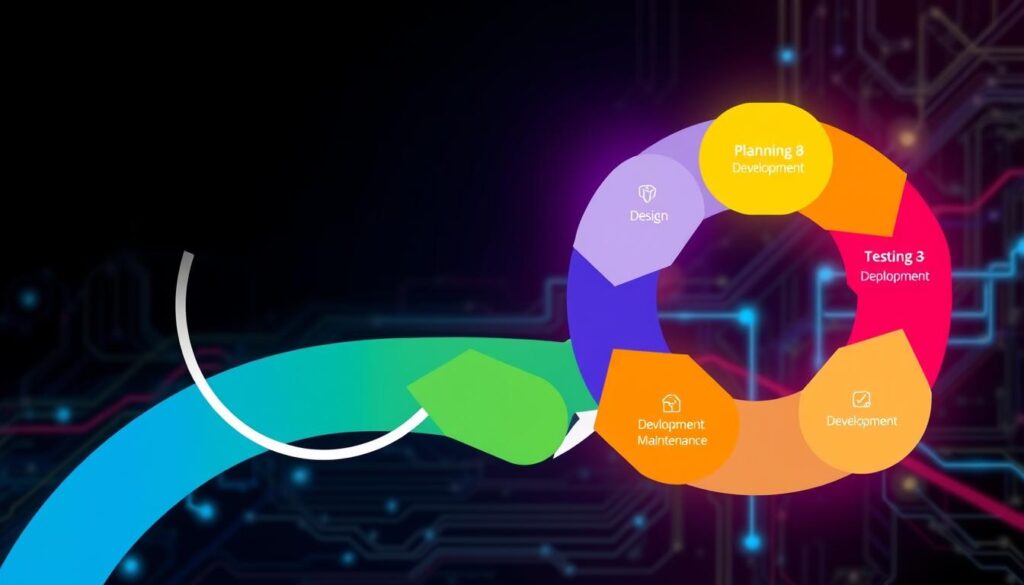In today’s world, software development services play a key role in tech progress. Turning a creative software idea into reality requires more than just innovation. It requires a strong plan, from the first idea to the final launch. This journey transforms a simple idea into a dynamic software product. Understanding software engineering solutions means seeing the importance of detailed planning and testing. Each step needs careful attention, managed by skilled software project management.
Seeing a software’s lifecycle is like preparing for a long race, not a short sprint. It can take years and moves through many phases. These include the starting idea, analyzing, designing, then building and testing. Getting a flexible yet structured plan is crucial for this complex journey. Doing this helps avoid problems, encourages teamwork, and leads to creating outstanding products. Products that not only work well but also surpass what customers expect.
Key Takeaways
- Understanding the comprehensive software product development process is key to innovation and market success.
- A well-planned and executed software development life cycle ensures alignment with business objectives and customer satisfaction.
- Transparent, structured processes are paramount for collaboration, vision alignment, timely delivery, and workload management in software project management.
- Adaptability within software engineering methodologies allows businesses to stay competitive and responsive to market needs.
- Utilizing tools like Jira facilitates software development services in managing complex tasks and optimizing quality assurance workflows.
- Strategically designed product roadmaps and collaborative tools significantly contribute to the success of software engineering solutions.
- A persistent focus on customer needs is essential for generating innovative ideas and achieving product-market fit.
Understanding Software Product Development
Starting software product development is complex. It needs careful planning, doing, and managing. With custom software development, businesses can make special solutions. These meet their exact needs and improve all areas of work.
Definition and Importance
Software product development covers many activities. It goes beyond just making apps to creating commercial solutions. It’s vital for meeting user needs well, placing companies ahead in the market with outsourced software developmentmethods. It includes market research, product planning, and launch strategies.
The Development Life Cycle
The development life cycle has several steps: start, plan, do, and finish. Each step builds on the last, matching development with user needs and business goals. This cycle adapts to new market trends and technologies. It also uses feedback to make products better and more relevant.
Key Stakeholders and Roles
In software development, many different people are involved. These include project managers, data analysts, UX designers, and QA testers. Everyone plays an important part, from planning the product to making sure it works well. Tools like Jira help them work together smoothly, tracking each development stage.
Knowing the key parts of software product development leads to strong results. Being efficient and aligned with strategy is key in software application development.

Ideation Phase: Turning Ideas into Concepts
The ideation phase is the creative core of software engineering solutions. Here, raw ideas are shaped into concepts ready to change markets. This stage lays the foundation in agile software development. It’s essential for the next steps of the project.
Market Research and Validation
Good ideation needs deep market research and validation. This ensures ideas are not only new but can work. Teams study the market, competition, and trends. This way, software solutions match real needs, raising the project’s success.
Brainstorming Techniques
- SCAMPER: Promotes seeing old elements in new ways
- Mind Mapping: Helps link different ideas to create creative solutions
- Silent Brainstorming: Lets quiet team members share ideas without speaking out
These methods boost creativity and explore many solutions. This makes managing the software project smoother.
Creating User Personas
User personas are made-up characters based on user research. They stand for the types of users of a service, product, or site. This approach helps developers meet user expectations better. By sharing these personas in the team, everyone stays aligned and clear during development.

To sum up, the ideation phase does more than just come up with ideas. It’s about refining them into successful software solutions. Through thorough brainstorming, validation, and creating user personas, teams can exceed user expectations.
Design and Prototyping: Shaping User Experience
In the world of creating software, design and prototyping are key. They turn ideas into working products. This stage is vital for agile development. It leads to better products by making small, quick changes.
Importance of User Interface (UI) Design
UI design makes software easy and fun to use. Good design combines looks with function. This mix is crucial for standing out in today’s market.
Developing Wireframes and Mockups
Wireframes and mockups show a software application’s layout. Tools like Adobe XD and Figma help make user-friendly designs. They guide developers and communicate ideas to stakeholders.
Utilizing User Feedback
User feedback helps improve products. Through testing, interviews, and surveys, developers learn what users want. This makes sure the final product is well-received.
Prototyping is a cornerstone of agile development. It helps find and fix issues early. This saves time and makes sure the product meets user needs.
Prototyping benefits from the lean UX approach. This emphasizes quick testing and updates based on user feedback.
For insights on prototyping and UI/UX, check this article. Prototyping is more than making things look good. It’s essential for functional and engaging software.
Development: Building the Software
In software development, choosing the right tech plays a big role in success. We’ll look at how to build strong software. This means aligning tech solutions with business goals.
Choosing the Right Technology Stack
Choosing the right tech stack is crucial. It means picking the languages, frameworks, and tools that match what the project needs. This choice speeds up development and ensures the software can grow.
Agile vs. Waterfall Methodologies
The development process choice impacts the workflow and results. Agile allows for changes and continuous testing. It’s great for projects with changing needs.
Waterfall, on the other hand, is more structured. You finish one phase before starting the next. It’s predictable.
Quality Assurance and Testing
QA and testing are key. They make sure the software works well and is safe. This stage finds and fixes flaws early, improving reliability.
Understanding key software development areas gives a strategic edge. Agile methods speed up development and adapt to changes. QA checks that the product is ready for launch. The right tech stack and engineering solutions drive success, affecting performance, user happiness, and satisfaction.
Launch and Post-Launch Strategies
The software product development process peaks at a detailed launch. This event starts the journey of a dynamic post-launch strategy. Successful launches push the software into the market. Yet, to stay relevant, it needs active involvement and constant betterment. Practices like effective marketing, embracing user feedback, and enhancing the product are key. These actions define success in creating custom software and outsourcing software work.
Effective Marketing Techniques
To stand out in the digital crowd with a software product, you need smart marketing. Marketing after launch keeps the interest up. It helps reach more people over time, beating competitors. Look at Dropbox’s referral campaign. It’s an example of how good marketing strategies after launch can bring great results.
Gathering User Feedback for Future Updates
Staying in touch with users after launching is crucial. It’s essential for businesses that develop custom software who want to stay ahead. User feedback guides updates so the software meets user needs better. Tracking how the product does in real life and customer happiness lets businesses update wisely. This means the software will meet expectations more closely, helping to keep users and engaging them better.
Continuous Improvement and Scaling
A software product is never fully complete. The search for the perfect features keeps going. Tools like Clearbit and user feedback help teams understand their audience better. A methodical process, like a five-step feedback loop, aids in continuous refinement. This is vital for businesses doing outsourced software work to create products that resonate with users. Slowly introducing the product to different types of users can fine-tune its offerings. This ensures the software not only satisfies initial needs but also grows to meet future expectations and technological developments.



